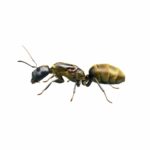



Camponotus mitis (Queen)
25,00€
Queen alone
Sold out
Receive in-stock notifications for this product
Scientific name: Camponotus mitis
Taxonomic classification:
- Kingdom: Animalia
- Phylum: Arthropoda
- Class: Insecta
- Order: Hymenoptera
- Family: Formicidae
- Genus: Camponotus
- Species: C. mitis
Geographic distribution:
The geographic distribution of Camponotus mitis is wide and is mainly found in Africa, but it can also be found in other tropical and subtropical regions of the world, such as:
- Africa: it is found throughout the continent.
- Asia: it has been recorded in countries such as China, Japan, India, Indonesia, Malaysia, Philippines, Sri Lanka, and Thailand.
- Australia: it is found in some parts of Australia.
- South America: it has been observed in countries such as Colombia, Ecuador, and Brazil.
Therefore, the geographic distribution of this species is quite wide and is found in several continents
Physical characteristics:
- Size: workers between 4-9 mm in length, queens between 10-12 mm in length.
- Color: generally black, with some species having reddish or yellow markings on the abdomen.
- Large and powerful mandibles used for cutting and transporting plant material.
Behavior:
- They are generally omnivorous, feeding on plant matter and small insects.
- Workers are polymorphic, meaning they can vary in size and function within the colony.
- They form relatively small colonies, with a few hundred workers.
Conservation status: Not present in any lists of endangered species.
Additional notes: Camponotus mitis is a common ant species in tropical and subtropical Africa and can play an important role in ecosystem ecology. Due to their ability to cut and transport plant material, these ants can be important in seed dispersal and in creating microhabitats in forest soil. Additionally, some species of Camponotus mitis have a symbiotic relationship with certain plants and can provide protection against herbivores and pathogens.
Related products
Camponotus lasiselene
Sold out
Polyrhachis armata
Sold out
Camponotus vanispinus
Sold out
Camponotus singularis
Sold out
Meranoplus Bicolor
Sold out
Camponotus japonicus
Sold out
























